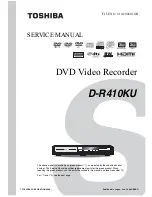
VITEK Industrial Video Products – Transcendent Series NVRs
65
7.3 Record Mode
7.3.1 Manual Recording
Method One
: Click
on the tool bar at the bottom of the live preview interface to enable
recording of the camera.
Method Two
: Go to live preview interface and then right-click camera image to pop-up a menu
and click “Manually Record On” in the camera window or click
on the tool bar under the
camera window to start recording.
7.3.2 Timing Recording
Timing Recording
: the system will record automatically according to the schedule.
Set the timing record schedule of each camera. See 7.1.2 Schedule Settings for details.
7.3.3 Motion Based Recording
Motion Based Recording
: the system will start motion based recording when motion occurs in
the field of view. The setup steps are as follows:
①
Set the motion based recording schedule of each camera. See 7.1.2 Schedule Settings for
details.
②
Enable motion and set the motion area of each camera. See 11.2 Motion Alarm for details.
The camera will start motion based recording once you finish the above settings.
7.3.4 Sensor Based Recording
①
Set the sensor based recording schedule of each camera. See 7.1.2 Schedule Settings for
details.
②
Set the NO/NC type of the sensor, enable the sensor alarm and then check and configure the
“Record”. See 11.1 Sensor Alarm for details.
7.3.5 AI Event Recording
①
Set the intelligence recording schedule of each IP camera. See 7.1.2 Schedule Settings for
details.
②
Enable the intelligence detection (object detection, exception, tripwire, intrusion or face
detection) and draw alert surface or warning area of each IP camera. See 9 AI Event
Management for details.
The camera will start AI recording once you finish the above settings. This function is only
available for some IPCs.
Note: Click Start
à
à
Settings
à
à
Record
à
à
Mode Settings and then set the manual record time in the
interface. Click “Apply” to save the settings.
VITEK Industrial Video Products – Transcendent Series NVRs
66
7.4 Disk
7.4.1 Disk Management
Ø
Disk Management
Click Start
à
Settings
à
Disk
à
Disk Management to go to disk management interface. You can
view the NVR’s disk number and disk status and so on in the interface. Click “Format” to format
the HDD.
Data Encryption:
①
Click “Data Encrypt”.
②
Enter the username and password used to log in the NVR. This username and password
should have the permission of disk management.
③
Check the disk you want to encrypt and then enter the password.
After you encrypt the data of a disk, this disk cannot be read by other NVRs unless it is
unlocked.
Data Decryption:
①
Click “Change Encrypt”.
②
Enter the username and password used to log in the NVR. This user should have the
permission of disk management.
③
Check the disk you want to decrypt and then empty the password.
③
Click “Close Encrypt”.
Unlock the disk: when one encrypted disk is transferred from another NVR to this NVR, it
will be in locked status. Then you can select this locked disk and click “Unlock”. After you
enter the password of its data encryption, its status will be “Read Only”. Now you can read the
data of this disk but it cannot be written too.
Some models may not support RAID function. The settings of RAID are as followings. Please
skip the settings of physical disk, array and disk mode if the NVR doesn’t support this function.
Ø
RAID
①
Enable RAID
(Go to Start
à
Settings
à
Disk
à
Disk Mode)
Содержание VT-TNR1646PF
Страница 185: ...NOTES ...
















































